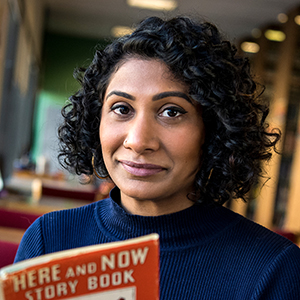
Divya Seshadri
Childhood Special and General Education '19
I learned techniques for hands-on, project-based learning that I use all the time. That's such a throughline at Bank Street in both the School for Children and the Graduate School.
Divya Seshadri is the committee on special education coordinator at Mary McDowell Friends School in Brooklyn, NY and a member of cohort 7 of the New York State Association of Independent Schools (NSAIS) Justice, Equity, and Diversity Institute. She works to bring more equity work and culturally responsive practices into her roles as educator and advocate, linking social studies with current events and expanding her school’s immigration curriculum. By pioneering an interview component, she has enabled students to welcome family members who had immigrated to the US into the classroom to share what their experiences looked and felt like. As an immigrant from Singapore, Divya also shares her own experiences with students and families.
“I’m here on a work visa,” she said, “so I went to each of the classrooms and spoke about my experience as someone who’s immigrated here, who’s working here, and all the constraints, challenges, and successes around that.”
To support her history curriculum about Indigenous people, Divya spent a summer conducting research and collecting stories from local Lenape people. As a result of her research, she invited a member of the Lenape Nation (based in Delaware) to visit her classroom where he shared cultural artifacts and a friendship dance.
Here’s what she has to say about her experiences in Bank Street’s Childhood Special and General Education Program.
What motivated you to come to Bank Street and become an educator?
Thinking about my experience in grade school, I can see that whenever I was interested in what I was learning, my attention, focus, and desire to delve deeper were much higher. But I grew up in a space that centered rote memorization, repeated practice of skill, and just using formulas. That didn’t work for me. I was a hands-on, project-based learner—I needed the visual and kinesthetic to learn. I thought about the teachers who brought success into my life and those who made me feel like I was not successful at all. I wanted to bring a different energy and perspective into teaching. I wanted to support kids in feeling differently about learning.
Which Bank Street experiences stand out to you?
In one class, we had to develop our own social studies curriculum, and my group decided to focus on food justice. With our curriculum, students mapped out food deserts and then visited the Union Square Green Market. We asked them to notice the restaurants in particular neighborhoods. We asked New York City kids to really think about food and how important it is to have the basic necessities. We talked about why people in some communities don’t have access to anything more than a deli or a bodega within walking distance.
And I also think a lot about my supervised fieldwork and our conference group. I got to know and work with other student teachers in the field who were in similar spaces and hear how they negotiated their classrooms and their pedagogical approaches.
What parts of your Bank Street experience do you bring into the work that you do today?
I learned techniques for hands-on, project-based learning that I use all the time. That’s such a throughline at Bank Street in both the School for Children and the Graduate School. That’s what I’ve tried consistently to bring into my teaching—to keep learning experiential, to keep students involved. If we’re learning about Frida Kahlo, then we’re going to try out some of her art styles. What is going to engage the students and how can I bring in student voices?
Also, I learned to not always just stick to the material or the content, but to remember to ask the students, “What do you want to do with this topic?” so they can really connect with what we’re learning.